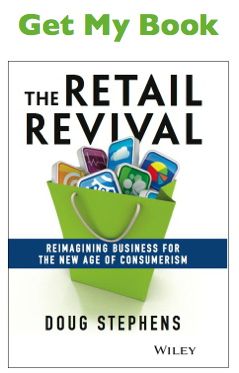By Doug Stephens

I, like you, don’t actually see everything my friends are posting on Facebook. Instead, I see only what Facebook’s newsfeed algorithm deems should be most relevant to me, based on my activity. Similarly, eBay and Amazon deliver product recommendations to my inbox, based largely on things I’ve viewed and bought in the past. And as most of us have experienced, after casually searching a product on Google, ads for that same product begin to routinely stalk us online for days, like a jilted lover that just won’t let go.
Increasingly the people, places and things that are making it into our field of consumer vision are being data-driven, algorithmically pre-determined and mathematically manifested. And it’s not just happening online; the physical retail world is also succumbing to the same phenomenon with companies like Google working successfully to connect online search with real world find. Apps like Google Now, for example, will deliver mobile notifications when items you’ve searched for on Google happen to be in your physical proximity.
The Shrinking Universe
In one sense I am a strong proponent of this new acuity of data as an antidote to the nauseating levels of mass advertising that have plagued us for the better part of a century. However, I also believe an overly data-centric approach to retail will have an anesthetizing effect on our online shopping experiences, increasingly sapping them of the exhilaration of accidental discovery.
Consider that not so long ago, the internet was largely untamed and very often seemed to propel us randomly into an ever-expanding universe of discovery – people, places and things we’d never before given thought to, could be stumbled upon in an exciting way. Now, it seems, we simply get wound into tighter circles of sameness, driven by a logic that we can’t see, don’t fully understand and that often seems not to understand us. Instead of expanding our options, the universe of possibilities seems to contract.
One Part Math, One Part Magic
This death of discovery at the hands of data presents a problem because the true joy of shopping lies in a delicate balance of relevance and randomness. While it’s true that as shoppers, we appreciate being shown things that appeal to our conscious needs and preferences, we also crave the delight of encountering shops we didn’t know we’d love, carrying products we never knew we wanted –the things that come out of nowhere to surprise and enchant us!
Retailers, who understand this dichotomy, have a tremendous competitive  opportunity ahead of them. As more online competitors move to data-driven customer analytics and auto-curated product offerings, smart retailers will take a more data-informed approach – treating customer analytics as directional in nature, while consciously injecting a healthy dose of humanoid randomness into both their communications with customers and the curation of their products. To recommend a percentage of products – not because they’re algorithmically relevant to a particular user profile but because someone believes they’re just totally awesome!
opportunity ahead of them. As more online competitors move to data-driven customer analytics and auto-curated product offerings, smart retailers will take a more data-informed approach – treating customer analytics as directional in nature, while consciously injecting a healthy dose of humanoid randomness into both their communications with customers and the curation of their products. To recommend a percentage of products – not because they’re algorithmically relevant to a particular user profile but because someone believes they’re just totally awesome!
It’s critical therefore, as we embrace an increasingly data-rich approach to business, that we not lose sight of the fact that great retail like so many other things is a unique and wonderful alchemy of insight, instinct and impulse. And data, no matter how good it is, can never replicate true serendipity.

